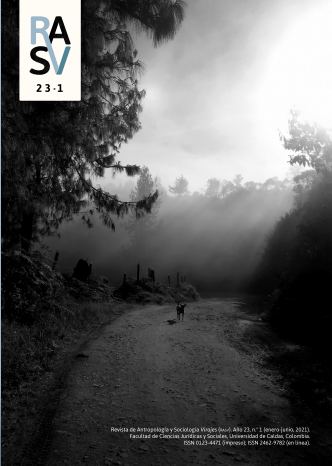Authors
Abstract
This article addresses the migration of Colombian students in Paris. The objective is to reflect about the processes through which a temporarystay city becomes a place of prolonged esidence. The research is based in a multi-sited ethnography and in-depth interviews conducted in France and Colombia. The text is divided into three sections: The first section explains the dual nature of transience of migrant students; the second section explores the context of departure; and the third section analyses the living conditions of Colombian students without scholarships in France. It is concluded that in order to understand the reorientation of the students’ project and the lengthening of their stay in Paris, it is necessary to address the context of origin and arrival in parallel, both at an individual and at a social and transnational level.
References
Aldana, E. (2001). Tendencias, retos y mitos de la educación superior en Colombia. Congreso Educación Superior, Desafío Global y Respuesta Nacional. Bogotá: Universidad de los Andes.
Ardila, M. (2019). Les paysages de la migration colombienne à Paris. Espaces traversés, espaces d’attente, espaces habités (Thèse de doctorat). École des Hautes Études en Sciences Sociales, París, Francia.
Bourdieu, P. & Passeron, J. C. (1964). Les héritiers: Les étudiants et la culture. París: Éditions de Minuit.
CEPAL. (2014). La juventud en Iberoamérica: Tendencias y urgencias. CEPAL, Organización Iberamericana de Juventud.
Cohen, É. (2001). Un plan d’action pour améliorer l’accueil des étudiants étrangers en France. Diagnostic et propositions [Rapport au Ministre de l’éducation nationale et au Ministre des affaires étrangères].
Coulon, A. & Paivandi, S. (2003). Les étudiants étrangers en France: L’état des savoirs [Rapport pour l’Observatoire de la Vie Étudiante (OVE)].
De Brito, X. A. (2009). «Avec du coeur au ventre». L’expérience des Bresiliens non boursiers à Paris. En C. Agulhon & X. A. de Brito (eds.), Les étudiants étrangers à Paris: Entre affiliation et repli (pp. 41-70). París: l’Harmattan.
de Gourcy, C. (2009). Partir pour revenir ou partir pour quitter. Le projet d’études des étudiants algériens. En S. Mazzella (ed.), La mondialisation étudiante: Le Maghreb entre nord et sud (pp. 97-115). París: IRMC, Karthala.
Ennafaa, R. & Paivandi, S. (2008). Le non-retour des étudiants étrangers: Au-delà de la « fuite des cerveaux ». Formation emploi, 103, 23-39.
GISTI. (2012). Le changement de statut étudiant à salarié. París: GISTI.
Gomez, V.M. (2000). Cuatro temas críticos de la educación superior en Colombia: Estado, instituciones, pertinencia y equidad social. Bogotá: Alfaomega, Ascun.
Hall, S. (ed.). (1997). Representation: Cultural representations and signifying practices. Londres: Sage.
Le Monde. (2020, july 1). Universités: Le Conseil d’Etat valide des frais d’inscription plus élevés pour les étudiants étrangers. Retrieved form https://www.lemonde.fr/societe/article/2020/07/01/universites-le-conseil-d-etat-valide-des-frais-d-inscriptionplus-eleves-pour-les-etudiants-etrangers_6044872_3224.html
Mankou, B.A. (2015). Mobilités étudiantes et lien social: Les étudiantes non boursières camerounaises dans le Nord-Pas-de-Calais . Hommes & Migrations, 1307(3), 67-74.
Melo, J.O. (1985). Crecimiento y expansión de la educación superior en Colombia: Una feria de ilusiones. Lecturas de economía, 253-271.
Melo, L., Ramos, J. & Hernández, O. (2014). La educación superior en Colombia: Situación actual y análisis de eficiencia. Borradores de Economía, 808, 59-111.
Ministère de l’éducation nationale de l’enseignement supérieur et de la recherche. (2019). Repères et références statistiques sur les enseignements, la formation et la recherche [Ressource électronique]. Retrieved from https://www.education.gouv.fr/reperes-et-references-statistiques-sur-les-enseignements-la-formation-et-larecherche-2019-3806
Pinto, C. (2013). Mobilité sociale et mobilité internationale d’étudiants étrangers: Trajectoires de jeunes professionnels chiliens et colombiens à Paris, New York et Boston. (Thèse de doctorat). Retrieved from ttp://www.theses.fr/s87414
Puyana, Y., Micolta, A. y Palacio, M.C. (eds.). (2013). Familias colombianas y migración internacional: Entre la distancia y la proximidad. Bogotá: Universidad Nacional de Colombia.
Rea, A. & Caestecker, F. (eds.). (2012). Migrer pour un diplôme: Les étudiants ressortissants de pays tiers à l’UE dans l’enseignement supérieur. Lovain-la-Neuve: AcademiaHarmattan.
Rolland, D. & Touzalin, M.H. (1994). Un miroir déformant? Les Latino-Américains à Paris depuis 1945. En A. Marès & P. Milza (eds.), Le Paris des étrangers depuis 1945 (pp. 263-291). París: Publications de la Sorbonne.
Sayad, A. (1999). La double Absence. Des illusions de l’émigré aux souffrances de l’immigré. París: Seuil.
Wagner, A.C. (2011). Les classes dominantes à l’épreuve de la mondialisation. Actes de la recherche en sciences sociales, 190, 4-9. https://doi.org/10.3917/arss.190.0004
Wihtol de Wenden, C. (2010). Le glissement des catégories de migrants. Migrations Société, 128, 193-195.
Yépez, I. y Herrera, G. (eds.). (2007). Nuevas migraciones latinoamericanas a Europa: Balances y desafíos. Quito: Flacso.

 pdf (Español (España))
pdf (Español (España))
 FLIP
FLIP



















